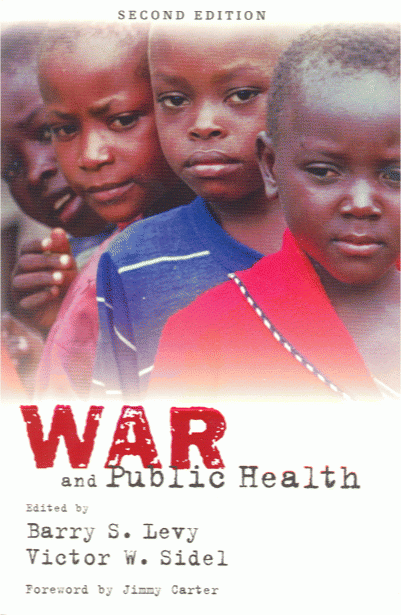 Back in the 1960s, peace activists sported a bumper sticker that read: “War is not good for children and other living creatures.” In a way, that sums up Barry S. Levy and Victor W. Sidel’s War and Public Health, where 46 experts on everything from epidemiology to international law weigh in on the authors’ central premise: “War and militarism have catastrophic effects on human health and well being.”
Back in the 1960s, peace activists sported a bumper sticker that read: “War is not good for children and other living creatures.” In a way, that sums up Barry S. Levy and Victor W. Sidel’s War and Public Health, where 46 experts on everything from epidemiology to international law weigh in on the authors’ central premise: “War and militarism have catastrophic effects on human health and well being.”
Levy and Sidel, both former presidents of the American Public Health Association, and distinguished researchers and practitioners in their fields, make the point that wars ultimately always come home. Young women and men are the most obvious casualties, shattered in body and mind on the battlefield. But war’s devastation includes the terrible things wrought by organized violence on the populations and infrastructures where wars are fought.
The authors consider the shock and awe of battle as just the beginning of war-inflicted damage. War means that nations divert their resources from things like education and health to smart bombs and high tech drones. War means choosing mayhem over economic development, exposing the most vulnerable in our society to disease and privation and the systematic destruction of the environment. “War threatens much of the fabric of our civilization,” write Levy and Sidel.
Thinking of war as a public health issue allows the authors to break the subject into digestible pieces: consequences, types of weapons, vulnerable populations, specific wars, and prevention. Each major section is divided into chapters, spanning everything from “The Epidemiology of War” to “The Role of Health Professionals in Postconflict Situations.”
According to a recent estimate by sociologist Chalmers Johnson, if all U.S. military-related spending were added together, it would come to about $1 trillion a year. Nobel Laureate economist Joseph Stiglitz posits that the lifetime costs of treating veterans of Afghanistan and Iraq will top $3 trillion. At the same time, according to the U.S. Census, 50.7 million people in the U.S. are currently without health care. Such are the tradeoffs the authors and contributors to War and Public Health find unacceptable.
The book is more than an expose, however. Levy and Sidel argue that public health officials should be as involved in preventing war as they be in stopping an epidemic.
Should the reader not know how to take action, the book includes an appendix with the names and contact information for virtually every international organization addressing war and peace.
“War is hell,” remarked Union General William Tecumseh Sherman. And so it is. But the authors of this well-written and accessible book argue that wars are not inevitable, and that time and again human beings have demonstrated a capacity to avoid them. On one hand, War and Public Health is an important and valuable effort to expose the consequences of war. On the other, it serves as a practical guide for creating a world where war is an anachronism and health is a human right.

